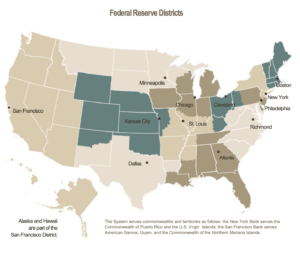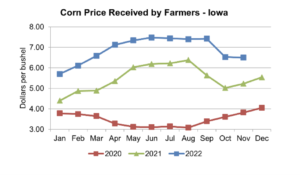Congress has quickly engaged in putting together potential aid packages for farmers that would more than double the Trump administration's $12 billion under the Farmer Bridge Assistance (FBA) Program.
Federal Reserve: Observations on the Ag Economy- January 2023
On Wednesday, the Federal Reserve Board released its January 2023 Beige Book update, a summary of commentary on current economic conditions by Federal Reserve District. The report included several observations pertaining to the U.S. agricultural economy.

* Sixth District- Atlanta– “Agricultural conditions were little changed from the previous report. Demand for poultry dropped slightly but remained strong; demand for cattle and timber, as well as for some row crops, such as corn and soybeans, held steady. Florida citrus yields were down notably due to damage from Hurricane Ian. The cotton market continued to soften amid decreased demand from textile mills. Supply chain disruptions persisted, with several contacts reporting delays in receiving machinery and parts.”
* Seventh District- Chicago–
After a strong year for District agricultural income, contacts expected lower but still solid returns in 2023.
“A contact suggested that many farmers will spend their gains on equipment and trucks, especially as availability at dealers had improved. With rivers rising, barge shipments returned closer to normal levels, easing shipping costs some. Furthermore, prices for inputs such as fertilizers, chemicals, and energy all moved down during the reporting period, and there was less concern about the availability of inputs. However, some contacts expressed worries about higher interest rates on farm loans. Soybean prices were higher, whereas corn prices were little changed.

“Egg and cattle prices continued moving up, while dairy and hog prices generally continued to move down. Most major agricultural prices ended 2022 higher than they were at the end of 2021.”
* Eighth District- St. Louis– “District agriculture conditions are favorable and have remained largely unchanged since our previous report. The percentage of winter wheat in the District rated fair or better decreased slightly from the end of November to the end of December. Rising commodity prices have pushed inflation-adjusted farm incomes to a near 50- year high, leading to an optimistic outlook for the upcoming year. However, input costs are on the rise as well, raising uncertainty on the overall effect on farmers’ margins for 2023.”
* Ninth District- Minneapolis– “District agricultural conditions were stable at high levels. Sector contacts reported that farm incomes and working capital remained strong heading into 2023.”
* Tenth District- Kansas City– “Agricultural economic conditions in the Tenth District were generally strong through the end of 2022 alongside elevated commodity prices. Prices of some key crops and livestock declined slightly during December but remained at a profitable level. Most contacts in the District reported gradual improvement in farm income and credit conditions, but others noted that drought had weakened conditions for some producers. Strong real estate values continued to bolster farm finances, but increased interest rates, high production costs, challenging weather conditions, and the outlook for commodity prices remained key concerns.”
* Eleventh District- Dallas– “Rainfall continued to improve soil moisture conditions, setting a good foundation for winter wheat and spring crops.

“Cotton exports declined, and contacts cited weak mill demand prompted by low consumer demand. Relatively high grain prices and promising soil moisture will likely favor an increase in grain acreage and reduction in cotton acreage next year.”
* Twelfth District- San Francisco– “Conditions in the agriculture and resource-related sectors remained generally weak. Overall domestic agricultural sales were up in terms of dollars but down in volume. Sales abroad varied by export market, with demand from Asian and European markets declining or remaining unchanged, while demand from the Middle East increased significantly. Global economic uncertainty and a generally strong dollar continued to put downward pressure on international demand.
Adverse weather conditions negatively impacted agricultural yields across the District, including for cherries, grapes, and nuts.
“Seafood production was also down, partially due to closures of crab fisheries in Alaska. Contacts noted that supply chain bottlenecks ameliorated further, but transportation and materials costs remained elevated. One producer in the Pacific Northwest noted that demand for timberland remained high, partially due to growing private interest in opportunities for carbon offset investment.”





